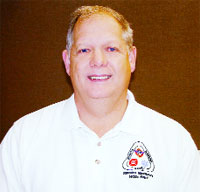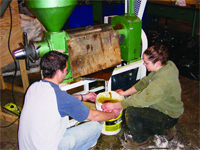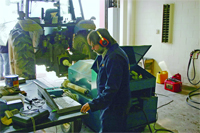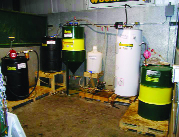
Equipment
Truck Checks: Bio diesel for the fire service?
Your department may be under pressure from your local politicians to be greener. The suggestion may be made to burn bio diesel in your apparatus. Let’s take a look and see if it’s for your department. Bio diesel can be made from the oil of corn, soybean, sea algae, canola, peanut and animal fats. There are other sources such as fish oil and palm oil but they are not as common.
February 28, 2008
By Don Henry
 Your department may be under pressure from your local politicians to be greener. The suggestion may be made to burn bio diesel in your apparatus. Let’s take a look and see if it’s for your department. Bio diesel can be made from the oil of corn, soybean, sea algae, canola, peanut and animal fats. There are other sources such as fish oil and palm oil but they are not as common.
Your department may be under pressure from your local politicians to be greener. The suggestion may be made to burn bio diesel in your apparatus. Let’s take a look and see if it’s for your department. Bio diesel can be made from the oil of corn, soybean, sea algae, canola, peanut and animal fats. There are other sources such as fish oil and palm oil but they are not as common.
When bio diesel is mixed with regular fossil fuel diesel the result is given as a B number, therefore a five per cent mixture is called B5 and a 20 per cent mixture is called B20. Bio diesel in a 100 per cent mixture can have as much as an eight per cent reduction in heat value. Therefore the common mixture of B20 would have a 2.5 per cent reduction in heat value. Here is one problem: if a diesel engine were 100 per cent efficient then at a B20 mixture you could be down only 2.5 per cent in power. But a diesel engine is, at best, 35 per cent efficient with about 65 per cent of the heat energy of the fuel leaving the engine as waste heat from the exhaust and cooling system. That means a B20 mix would cause a reduction of power closer to seven or eight per cent. While its hard to say if this could cause a worn engine to fail a pump test, I would want to conduct my yearly pump test with 100 per cent No. 2 diesel (you do a yearly pump test right?). Remember No. 1 diesel is the lighter, less powerful winter fuel.
 |
| Students at Lakeland College crush canola. PHOTOS COURTESY DON HENRY |
Bio diesel does have many advantages. For example, bio diesel has excellent lubrication qualities. It also reduces emissions of carbon dioxide, particles of soot, polycyclic and nitrated hydrocarbons and sulfates. There is as small increase in NOX but only at the B 100 level.
As many of you haven been following the progress of the ultra low sulfur levels in diesel fuel you will be happy to know that bio diesel contains no sulfur, unless the bio diesel is made from oil that was used to deep fry onion rings.
In fact, bio diesel has a lubrication property at the B2 level that more than compensates for the loss of lubrication of the fuel injectors that we, in the past, got from the higher sulfur fuel.
Another drawback to bio diesel is that it does biodegrade over time. This could be a problem for some rural department or departments that have units that have been put into reserve or second-line service. Fuel will begin to degrade in the fuel tanks of both the engine and the fuel storage.
Bio diesel is a very good cleaner and solvent; any contamination that has settled out on the bottom of the fuel tanks of older units will be put into suspension. That’s a nice way to say that if you’re lucky, the fuel filters will become plugged. That’s also why most bio diesel will not be put into the refinery pipelines but will be tank mixed just before delivery.
 |
| Dynamotor testing of bio diesel fuels by Rob Baron at Lakeland College.
|
Be very careful that water does not mix with the bio diesel and that the bio diesel you buy is very dry (also called neat). Bio diesels have the ability to keep water in suspension and not let the water coalesce at the water filters or settle out in water traps. Any water that can make it past the filters will have damaging effects on the engines fuel injectors.
There is a standard to keep people from producing sub-standard fuels; its the ASTM 6751 fuel test. It costs about $1,500 to conduct a full test at a certified lab but don’t even think about getting fuel that does not meet this test. Demand proof of the test before you buy.
The process of taking oils and fats and refining them to bio diesel is not really complicated but needs to be done and done correctly. No matter what you may have heard or seen on a television newscast you can not pour used French fry oil directly into your diesel fuel tank and expect it to work for any length of time. My college here in Vermilion has been making bio diesel for many years.
 |
| Bio diesel lab at Lakeland College.
|
We use a B5 mixture in our student-managed farm equipment and a near B100 mixture in our indoor tractor that maintains our student horse-riding arena. Because of the cold temperature waxing problem we don’t use a mixture of higher than B5 for our outdoor winter equipment.
In conclusion, is bio diesel for the fire service? I would have to say no; the risks do not outweigh the benefits for a service that uses such a small amount of fuel. Let’s burn it in our garbage trucks, city snow removal and bus fleet but at this time I cannot in good conscience recommend it for the fire service. If you are forced to use a bio diesel mix use only a B5 and be prepared for the replacement of fuel filters on older in service units.
I have an excellent Powerpoint produced by Rob Baron, my college’s resident bio diesel expert, that I can send to you. E-mail me at don.henry@lakelandcollege.ca .
| BIO DIESEL PRIMER
Source: Natural Resources Canada |
Don Henry teaches in the Automotive Service Technician and Heavy Equipment Technician programs at Lakeland College in Vermilion, Alta., where he has been a faculty member for more than 17 years. He has co-developed and delivers Canada’s only post-secondary level fire-apparatus maintenance program and has completed a textbook on fire apparatus.
Print this page